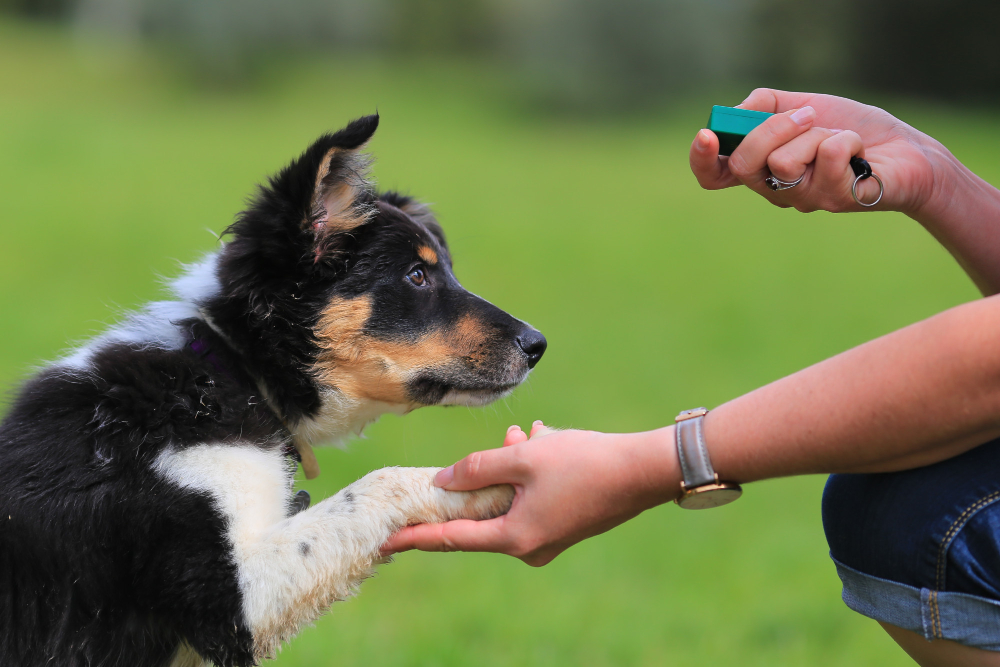When used correctly, a clicker can be an excellent training aid. Even if it isn’t strictly necessary, it makes studying more fun. However, human-created learning markers aren’t necessary for animals to acquire new skills.
In cases where immediate reinforcement is available, a marker may not be necessary. For example, positive reinforcement training with a clicker is the same as clicker training—just a tiny mechanical sound generator; the clicker is all you need.
Using these techniques, which are based on research into animal learning, we can increase the likelihood that an action will be repeated in the future. Consequently, instead of focusing on what your dog has been doing improperly and taking good behavior for assumed, clicker training should focus on what your dog is doing well and rewrite the training rules.
When a reward or treat is consistently associated with a clicker, it can be called a trained reinforcer. If you instruct your dog instead of telling it what it should not do, you can significantly impact how your dog chooses to be.
Your dog will know exactly what actions you want to reward with a clicker since it makes it apparent to him. Whenever your dog does what you desire, you may “mark” the exact moment by clicking at the right time.
Consequently, your dog doesn’t have to guess about your favorite parts because the click tells them just what you enjoyed. You could hit your clicker the second your dog’s rear touched the ground if you were teaching him how to sit, for example.
What Can I Use Instead of a Clicker?
Good behavior is reinforced with clickers, which are excellent training aids. To save money, you can make your dog clicker at home rather than purchasing one from a pet store.
Jar lid clicker
- Use a hammer to rap the jar’s lid’s center repeatedly. An indentation in the lid of the jar is needed to produce the clicking sound.
- Flip the jar lid over in your hand. It should now be open. The jar lid’s center should protrude from the jar body. To ensure, tap the lid a few more times with a hammer on a flat surface, face down.
Flashlight clicker
- Each of these buttons must be present for the flashlight to function correctly. The button produces the clicking sound. At the bottom of the flashlight, you’ll usually find a rubber button.
- Remove the batteries by unscrewing the flashlight’s cap.
- The flashlight needs to be reassembled. Replace the bottom half of the flashlight with the top half. Keeping twisting till the two pieces are firmly joined is the goal.
Tin can clicker
- Scissors can be used to cut a square out of the can side. First, fold the square in half from each of the four corners. Each corner should be folded such that the tip hits the concave face of the strip at the center.
- Attach the square to the little plastic lid by taping two opposing edges of the square. Apply tape so that the curved edge of the square strip sticks out above the lid.
- Make a clicking sound by pressing down on the bent aluminum strip. When you press the center of the strip, you should hear a popping sound.
Can I Train My Dog Without a Clicker?
Reinforcement must follow an action promptly to be linked to it, but any signal that anticipates reinforcement turns reinforcing in its own right. When a dog understands whatever the event marker signifies, the event marker begins the process of reinforcing that understanding.
Because of this, the trainer can still present the significant prize, even if she’s across the room. Event markers are best and most beneficial when they forecast more robust items, but they can also encourage behavior independently.
Something like reaching for your pocket full of treats will start the process even if a clicker or other specified marker isn’t used. Without this awareness, you may be reinforcing something about what you originally intended.
The clicker works effectively partly because the dog has never heard it before and has no prior associations, making it easy to create strong associations. However, this isn’t always the case.
The clicker may have predicted an aversive sound, or the dog may be susceptible to unfamiliar noises. Dogs can learn to detest or ignore a clicker because they are sold with no instructions, and they may have been accidentally used to reprimand or interrupt a dog’s behavior.
Using a clicker does not have to be difficult if your dog cannot sense or tolerate the device’s sound. Even though clickers are used to train actions at the beginning, less precise markers are typically used once the behavior is mastered. When training your dog, the most important thing to remember is that communication is an essential part of the process.
Can I Use a Pen Instead of a Clicker?
A retractable pen can also be used as a clicker if it emits a loud and distinct sound. For example, you offer your puppy an order, such as “sit,” and the dog responds with a “click.”
- The clicker should be introduced to your dog before you begin training. Then, after clicking the clicker once, give your dog a treat as soon as you’ve clicked it.
- Repeat this several times to help your dog correlate the click with such a reward. The click should begin to draw your dog’s attention as soon as this association is created.
- The next step is to direct your dog’s attention to the desired behavior, such as sitting. Give a treat to your dog as soon as he sits.
- You can click and give your dog a treat every time they sit after gently encouraging him. Your dog will soon connect between the desired action, the click, and the treat.
- After mastering this first step, reward your dog solely when they do the activity in your spoken order. For example, if your dog sits on its own, don’t encourage him with praise or a clicker.
- As your dog consistently sits when commanded, you can gradually reduce or eliminate the use of the clicker and goodies. As you wean your dog off the clicker, some trainers recommend substituting a marker word like that of an enthusiastic “yes!”
- As soon as your dog learns to obey your voice commands consistently, you can cease rewarding them with goodies each time they succeed. However, continue to pat him on the back and offer plenty of praise. Of course, if your dog is paying attention and obeying your commands, you can reward him with a tasty treat.














